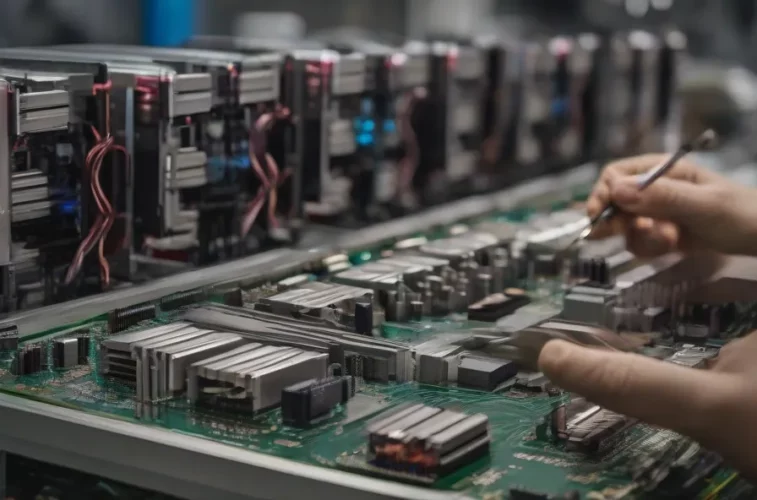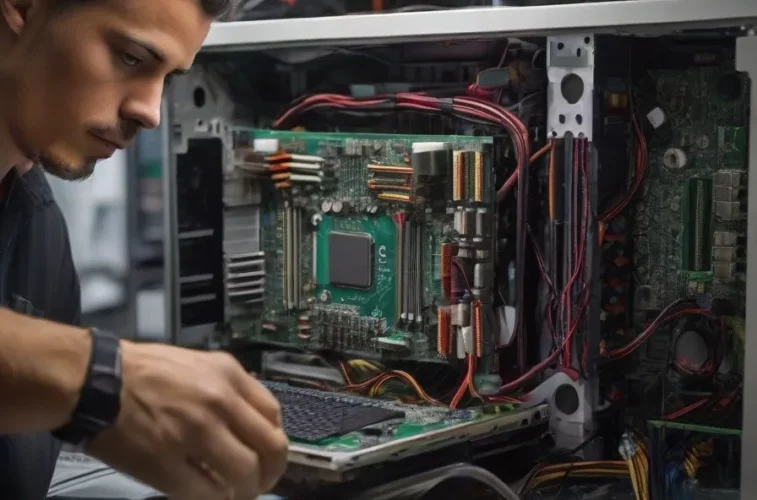Replacing a motherboard can be a daunting task for many, but with the right guidance, it becomes a manageable and crucial skill for maintaining and upgrading your computer. In this comprehensive guide, we’ll walk you through ‘how to replace a motherboard’ step by step, discuss the costs involved, the manufacturing intricacies, and shed light on the importance of motherboards in the grand scheme of a computer system.
7 Essential Steps To Replace a Motherboard

1) Gather Necessary Tools and Equipment
Before diving into the replacement process, it’s essential to have the right tools on hand. From screwdrivers to thermal paste, we’ll outline the tools needed for a smooth motherboard replacement.
2) Back Up Your Data
Ensuring your data is backed up is crucial before making any hardware changes. We’ll discuss the importance of data backup and recommend reliable methods to secure your information.
3) Disconnect and Remove Components
Learn how to safely disconnect and remove components such as the CPU, RAM, and GPU. Proper handling during this stage is crucial to prevent damage to these sensitive parts.
4) Remove the Old Motherboard
Follow a detailed guide on removing the old motherboard from your computer case. Tips on handling and storing the old motherboard for potential future use will be covered.
5) Install the New Motherboard
With the old motherboard out, it’s time to install the new one. We’ll guide you through aligning the motherboard, securing it in place, and connecting all necessary components.
6) Connect Cables and Components
Connecting cables and components correctly is key to a successful motherboard replacement. We’ll provide a checklist to ensure everything is properly connected.
7) Power Up and Test
The final step involves powering up your system and conducting tests to ensure everything is functioning correctly. Troubleshooting tips will be provided for common issues.
How Much is a Motherboard Replacement?
Understanding the costs associated with motherboard replacement is crucial for budgeting and decision-making. In this chapter, we’ll explore the various factors influencing the costs.
Factors Influencing Costs
Delve into the factors that contribute to the overall cost of a motherboard replacement, such as brand, compatibility, and the type of device.
Some Motherboards To if You Replace With New one: MOTHERBOARDS FOR AMD & INTEL
Importance of the Motherboard in a Computer System
Understanding the critical role a motherboard plays in your computer system is fundamental to appreciating its significance. This chapter explores the importance of motherboards in ensuring smooth and efficient operation.

1) Central Hub of Communication
The motherboard serves as the central hub that connects and facilitates communication between all essential components of a computer. This includes the CPU (Central Processing Unit), RAM (Random Access Memory), storage devices, graphics card, and other peripherals. Information and data flow through the motherboard, allowing seamless interaction between different parts.
2) Compatibility and Expansion
The motherboard dictates the compatibility of various hardware components. Different motherboards support specific CPU socket types, RAM modules, and expansion slots for graphics cards and other peripherals. Understanding the compatibility ensures that the components work together efficiently. Additionally, the motherboard provides expansion slots for adding new hardware, allowing users to upgrade and customize their systems.
3) Power Distribution and Regulation
The motherboard manages the distribution and regulation of power throughout the system. It includes power connectors for the CPU, RAM, and other components. Voltage regulators on the motherboard ensure that each component receives the appropriate amount of power, preventing damage due to over-voltage or under-voltage situations.
4) BIOS/UEFI Firmware:
The Basic Input/Output System (BIOS) or Unified Extensible Firmware Interface (UEFI) is stored on the motherboard. This firmware is essential for initializing and configuring the hardware components during the boot process. Users can access the BIOS/UEFI settings to configure system parameters, update firmware, and troubleshoot issues.
5) Memory Management
The motherboard hosts the RAM modules, which are crucial for temporary data storage and quick access by the CPU. The memory controller on the motherboard manages the flow of data between the RAM and the CPU, influencing the overall speed and responsiveness of the system.
6) Peripheral Connectivity
Motherboards provide various ports and connectors for connecting external peripherals such as USB devices, audio devices, networking components, and more. The type and number of these connectors vary between motherboards, allowing users to customize their systems based on their specific needs.
7) Expansion and Upgrade Flexibility:
Motherboards feature expansion slots for additional components, such as graphics cards, sound cards, and networking cards. This flexibility enables users to upgrade their systems by adding new and more powerful hardware, extending the lifespan and capabilities of the computer.
8) Form Factor and Case Compatibility:
The form factor of the motherboard determines its physical size and layout. This, in turn, influences the type of computer case it can fit into. Different form factors, such as ATX, micro-ATX, and mini-ITX, cater to various system sizes and designs, providing options for desktops, workstations, and compact systems.
9) System Stability and Reliability
A well-designed and high-quality motherboard contributes significantly to the overall stability and reliability of a computer system. Reliable power delivery, efficient heat dissipation, and quality components reduce the risk of system failures and enhance the lifespan of the hardware.
10) Integration of Advanced Features
Modern motherboards often integrate advanced features such as Wi-Fi connectivity, Bluetooth support, RGB lighting control, and multiple M.2 slots for high-speed storage. These features enhance the user experience and allow for the creation of high-performance and feature-rich systems.
The time required to replace a motherboard depends on factors such as your familiarity with the process, the complexity of your system, and any unexpected issues that may arise. On average, it can take anywhere from 1 to 3 hours for a straightforward replacement.
In most cases, a motherboard upgrade requires a fresh operating system installation. The new motherboard may have different drivers and configurations, making a clean install necessary for optimal performance.
No, not all motherboards are compatible with all CPUs. Motherboards have specific socket types that determine which CPUs they can support. It’s crucial to check the compatibility between the motherboard’s socket type and the CPU before making a purchase.
It depends on the specific circumstances. If the old computer meets your current needs and upgrading components isn’t cost-effective, replacing the motherboard might not be worth it. However, if you require modern features or improved performance, upgrading could be a viable option.
Signs of a failing motherboard include frequent system crashes, unexplained errors, and hardware components not functioning correctly. Additionally, if the motherboard is outdated and incompatible with modern software and hardware, it might be time for a replacement.
While it’s technically possible to replace a motherboard without reinstalling Windows, it’s not recommended. Differences in hardware can lead to stability issues and performance issues. A clean Windows install is generally advised for a smooth transition.

